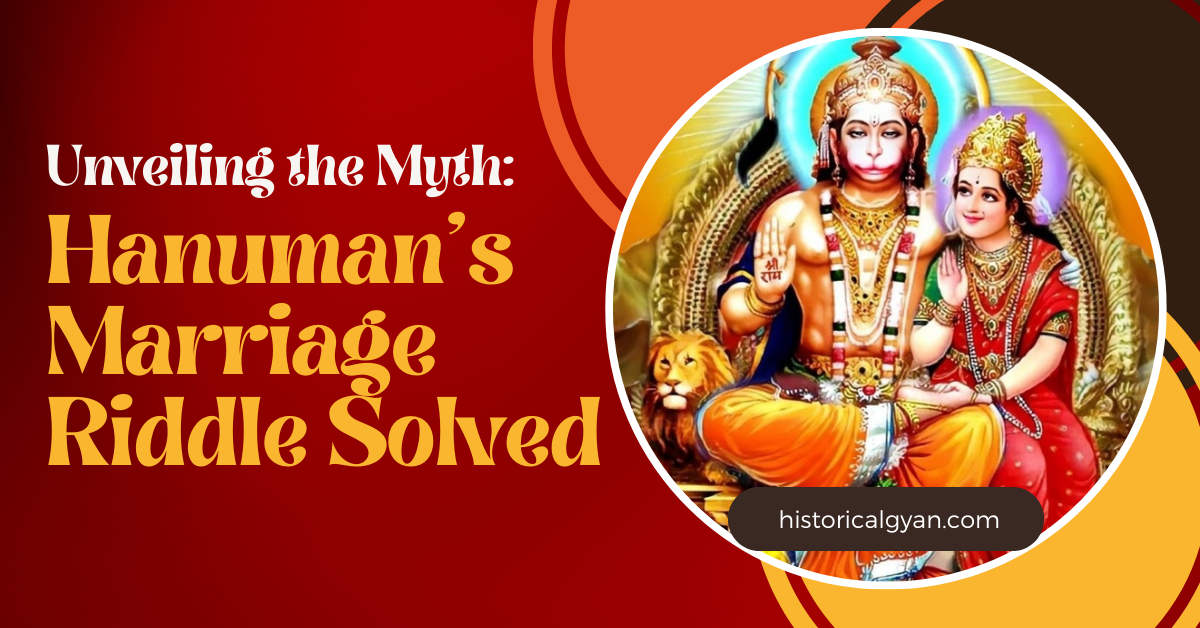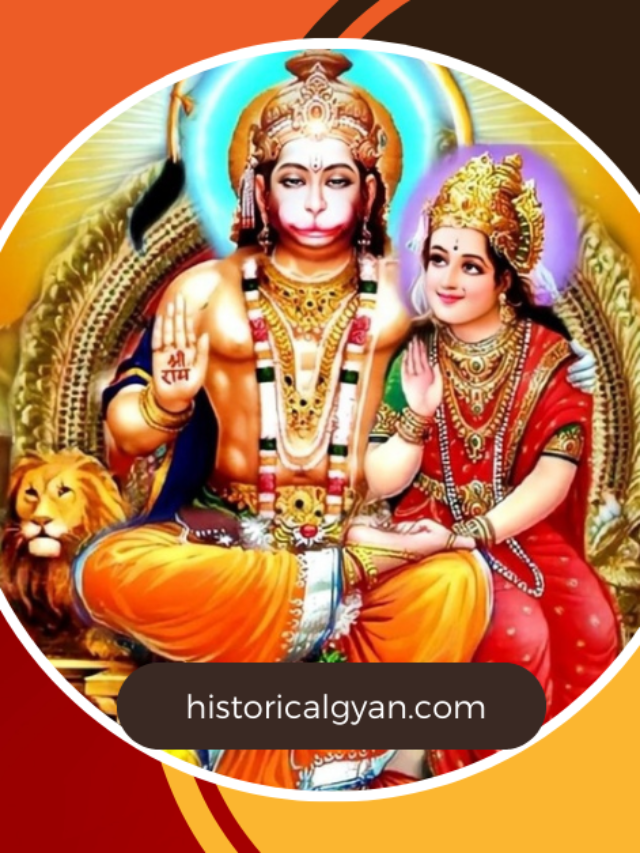Hanuman, an iconic figure in Hindu mythology revered for his unwavering devotion to Lord Rama, has long been regarded as a celibate, completely committed to his devotion. However, most Hindus believe that Lord Hanuman was a follower of celibacy and had complete control over his mind, body and senses. Yet, amid the prevalent belief in his celibacy, questions frequently arise regarding his marital status.
Marriage of Hanuman
- Was Hanuman married?
- Did Hanuman have any wife?
- Did Hanuman have children?
Delving deeper into ancient texts such as Valmiki Ramayana, Shiv Purana, Vishnu Purana, Devi Mahatmya, Skanda Purana and Shri Ram Charitmanas, a consistent narrative emerges – Hanuman observed a vow of celibacy by renouncing marriage and all forms of intimate relationships. .
However, interesting folklore offers alternative stories suggesting marital relations of Hanuman. Among these, the legend of Suvarchala, allegedly the daughter of Surya, is linked to the life of Hanuman. The Hanumanatha Mangalashtakam, a revered verse, depicts Hanuman as the wife of Suvarchala, a depiction that differs from the traditional understanding of his celibacy.
However, There are quite a few popular stories from the folk tales associated with Hanuman’s marriage. let us go through each of those in this article.
Alleged Marriage of Hanuman
Suvarchala Kalathraya,
Chathurbhuja dharaya cha,
Ushtra roodaya veeraya ,
Mangalam Sri Hanumathe.
“The auspicious name of Shri hanuman,
Who is the consort of Suvarchala,
Who had four arms,
And who is the hero who rides,
On a beam of light.”
Gruhasth– In sanskrit means a man who leads a family life after marriage.
She was created to be married to Hanuman to make him a Gruhasth without compromising on his brahmacharya.
Thus Hanuman was married to Suvarjaladevi and they both continued to maintain their celibacy even after marriage.
A very important part of the story is that the Trimurti ensured to do everything in their power to educate Hanuman on all the Siddhis and Vyakarn as in the future, Hanuman would be the next Brahma while his consort Suvarchala would occupy the place of Vani.
A strong contradiction in Markandeya Purana

As interesting as the story may seem there is a strong contradiction to the story in “Markandeya Purana”. as per this text, Suvarchala was one of the seven wives of Surya and Hanuman is referred to as their son

This verse shown on the image is taken from ‘Markandeya Purana’ and translates as:
“The wives of the sun and the other manifestations, termed rudra and the rest were respectively, Swarchala, Uma, Vikeshi, Siva Svaha Disa diksa and Rohini”.
Now hear an account of their progeny by whose successive generations this world has been populated their sons, then were severally, Sanisocara (Saturn), Shukra (Venus), Manojava(Hanuman), Skanda Swarga Santana and Buddha (mercury).
Inspire of this debate, of whether Suvarchala was married to Hanuman or not, there is a famous temple in Andhra Pradesh named “Sri Suvarchala Sahitha Hanuman”. It is believed that couple whose marital life is deteriorating reach here to pray for their marital issues to be resolved.
Suvarnamacha, Ravana’s Daughter
 The Thai version of Ramayana mentions the daughter of Ravan named Suvarnamacha who was a mermaid.
The Thai version of Ramayana mentions the daughter of Ravan named Suvarnamacha who was a mermaid.
In this story, Ravan calls for his daughter Suvarnamacha and demands her to destroy the bridge. Being constructed by the Vanar Sena. He only gives her half the information and tells her that his kingdom is being attacked by ‘Ram’.
Suvarnamacha tried to wreak havoc and tear down the Nalasetu now also known as Ram-Setu. when Hanuman finds out about this plan, He meets suvarnamacha and explains to her the wrong doings of Rawan and narrates to her Ram’s side of the story. He requests her not to interfere or distract the army.
Suvarnamacha is taken aback by the truthfulness and humility of Hanuman and accepts his request and meanwhile also confesses her love. Hanuman informs her that he was a celibate and a true follower of brahmacharya. which meant that
would never love or marry her. but upon Suvarnamaccha’s request, through his divine powers he blesses her with a son. this Thai version of Ramayana is often unheard of and is not accepted for authenticity amongst the Hindus in India.
Anangakusum, Ravana’s Niece
In a few parts of india there is a popular folk tale that mentions that long before the abduction of Sita, Hanuman fights a battle with Ravan on behalf of varundeva (God of water). Hanuman eventually wins the battle and decides to hold ravana and his sons captive.
Ravan decides to give up and comes in peace to Varundev. impressed by the courage and strength of Hanuman Ravan out of curiosity tries to find more about Hanuman. he comes to know from his sources that Hanuman was a reincarnation of ‘lord Shiv’. Ravan offers his niece Anangkusum‘s in marriage to Hanuman. Anankusum was a daughter of kharadushan and Ravan’s sister ‘Chandranakar’.
As tales go, Anangkusuma was a huge devotee of ‘lord Shiv‘ and wanted to marry him. Shiv impressed by the integrity of her devotion accepts her prayers and blesses her that he will marry her in his reincarnated form. Since Hanuman was an incarnation of lord Shiv or Rudra himself, he was obligated to marry Anangkusam but did so only with the condition that he will continue to remain a celibate even after their marriage.
Satyavati, Daughter of Varun
This story is extremely similar and related to the previous story of Hanuman fighting against Ravan on behalf of Varun. After Hanuman’s victory, Varun dev was impressed by Hanuman and wishes to marry his daughter Sativati to Hanuman.
He approaches Hanuman’s mother Anjana and offers his daughter’s hand in marriage and Anjana accepts without knowing her son’s vow of celibacy. To keep the word of his mother, Hanuman married Sativati with the condition to remain a celibate or a brahmachari throughout his life.
The Tale of Makardhwaja

While these were the story of Hanuman’s wives, there is also another one that revolves around his son Makardhwaja. This story is a part of “Adhabhut Ramayana” which narrates that when hanuman took a dip in The Indian ocean after burning down the whole of Lanka with his inflamed tail, a drop of his sweat fell into the mouth of a Fish. The Fish later gives birth to his son ‘Makarthwaj’, who goes on to become the Gatekeeper of Patallok, which was under the control of Ravan’s cousin Ahirawan.
Even the character of Ahirawan that appears in ‘Adbhuta Ramayana’ does not exist in the original Valmiki Ramayana. So these were the various stories associated to Hanuman’s marriage.
Analysis and Authenticity
These stories, while intriguing, lack unanimous validation in renowned scriptures like Valmiki Ramayana. The discrepancies among various regional and folk narratives pose challenges in confirming Hanuman’s marital status. The original scriptures predominantly emphasize his dedication to celibacy and unwavering devotion.
Neither Valmiki Ramayan nor do any other authentic epics mention the existence of Ravan’s niece Anankusum. On the contrary,
As per the original Valmiki Ramayana the first time Ravan meets Hanuman was when his son Megnath had captured Hanuman after he had killed his brother Akshaykumara.
Valmiki clearly narrates the incident of Hanuman introducing himself to Ravan as the messenger of Ram.
Temple and Folk Beliefs

Interestingly, despite the discrepancies, several temples across India, such as “Sri Suvarchala Sahitha Hanuman,” reinforce the belief in Hanuman’s marital alliances. Such temples are often sought by couples facing marital discord, seeking resolution through the deity’s blessings.
Conclusion
While the narrative of Hanuman’s marriage to Suvarchala persists in folklore, the foundational texts and ancient scriptures resoundingly uphold Hanuman’s unwavering commitment to celibacy and the absence of a marital union. These narratives, though intriguing, remain divergent from the essence of the revered figure as portrayed in authentic scriptures.


